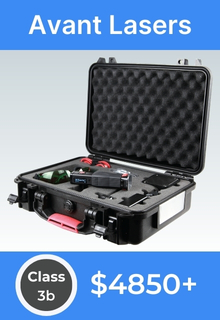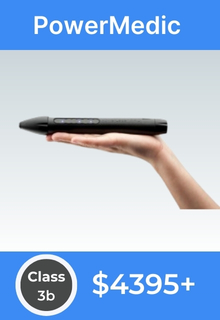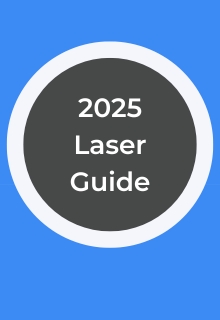14 Ways to Use a PBMT Laser
This article is an excerpt for our training program that covers most of the major theories for the best use of low level lasers therapy (LLLT) and high intensity lasers therapy (HILT). The following is a general summary of the major concepts behind the different kinds of therapy . If you study the greater PBMT market, you will see that different companies have developed different theories of what makes a great therapy device and what is the best way to treat patients.
Therapy lasers and the concept of photobiomodulation (PBM) can be applies to heath issues in a wide variety of ways. Of course, an acupuncturists will treat an injury in a very different format than a PT, chiropractor or DO but there is also a huge variation in the different styles of therapy within the same profession based on each practitioners training and instinct. The following is a list of different theories of how to use a laser and how to deliver the highest efficacy.
1. Direct treatment (Dosage Based)
The most common theory and probably the highest efficacy in laser therapy is the direct treatment of an area where there are know damaged cell. If the cells were once healthy and are now damaged and lacking the energy to repair themselves (ATP), applying an appropriate dosage seems to provide the most consistent results. Most class 3 manufacturers promote a medium dosage as recommend by the European laser association. The class 4 manufacturers follow the dosage theory too but they believe that the higher the dosage, the better the results. The theory of applying an appropriate dosage (at an appropriate wavelength) is the cornerstone of the mainstream laser therapy community.
2. Pulsing Based Therapy
Another common theory of LLLT is based on pulsing on and off the laser to stimulate the body. Some companies take this to extremes and promote protocols with a negligible dosage but emphasis on a specific pulsing frequency of the laser. This type of treatment is mainly championed by Echonia who spends a lot of time in chiropractic schools educating student on their theory. Their newest systems are just 20 mw so a 10 minute therapy session only 12 joules at the surface and less than 1 joule at depth. This company also says it is OK to treat through clothing so they definitely donā??t care about the dosage since a dark shirt could absorb 90%+ of the dosage. In some cases, low dosage pulsing-based systems deliver great results but we typically recommend a combination of reasonable dosages and pulsing to provide the best of both worlds.
3. Multi-Wavelength Therapies
The use of different wavelengths for different applications has been well established by several different manufacturers (mostly Thor, Avant and K-laser). If budget is not an issues, multiple wavelength system add flexibility and allows practitioner to experiment outside the core photobiomodulation applications where we see the best results. For 70% of laser application (where we see the highest efficacy), we recommend a primary wavelength of 800 to 860 nm for most applications. The next most common wavelengths are 630 - 660nm and 905 - 910nm. Wavelengths above this range are basically heat lamps since most if their energy is absorbed by the water in tissue and not the cells. 980nm is good as muscle relaxer and it can increase circulation so it is a good secondary or tertiary wavelength but it is not a good primary wavelength. Below this range, there is very little science to justify the use. It seems that the more fringe companies add exotic wavelengths in the blue, pink, purple and green wavelengths so they can distinguish themselves from the core laser therapy companies but there is very little science to justify these wavelengths and some wavelengths (like blue-UV) are actually dangerous and can cause disrupt DNA.
4. Acupuncture Therapy
A small focused laser with a typical power level of around 100 to 500mw can be used exactly like a needle is used in acupuncture. The dosage is typically 2 - 8 joules per point (at the surface) and accomplishes the same energy release about 98% of the time. Laser acupuncture is great for kids and others who donā??t like the feelings associated with needles. This type of therapy is based on releasing the blocked energy inside the body so that the body is in balance and this should accelerate natural healing.
5. Trigger Point Therapy
Similar to acupuncture, trigger point therapy is common with some chiropractors, message therapist, and physical therapist. During a conventional trigger point therapy session, pressure is applied to the painful points for several second to help relax the problematic muscle. A laser with a small blunt tip can be used to release the point and at the same time, it is adding laser energy to this critical point. You will often see these in treatment protocols as a static treatment point. If your system does not have a trigger point probe, you can typically use a laser with a larger treatment area to accomplish a similar result but class 4 systems over 3 watts can potentially overheat the spot if not kept moving.
5.1. Palpation & Therapy
Similar to trigger point therapy, we have heard from several doctors that the secret to great laser therapy is palpation. In this process, the practitioner tests and examines the body to find areas that need attention. This can include range of motion assessment, muscle strength testing, special tests, joint mobility assessment, and neurological assessments. Problem areas may also exhibit redness, heat, and swelling. This data is used to determine the weaknesses in the health of the patient, the laser can then be used to add energy to any weak or painful area.
6. Dual Treatment Densities
When an area like an ACL becomes damaged, the entire surround area typically becomes inflamed. It is the best practice to get a high photon density in the damaged area AND a lower density in the surrounding activated area. This theory is that you are treating both the problem (higher dosage) and the symptoms (lower dosage). This can also provide superior outcomes if the patient is misdiagnosed and the real problem is not clearly defined because they are at least getting some energy in the area of the root cause.
7. Somatic Reset
There is a good underlying rationalization for why some people need a somatic reset. In many people with chronic pain and misalignment, their body has adapted to the health problems by perpetually holding the body in a position to minimize the pain. This causes a cascading effect as other parts of the body become chronically tight, fatigued and always on the verge of collapse. A somatic reset can be achieved using an large dosage over a large area to reset the nervous system. This is typically done by treating the entire back from the hips to the brain stem with some additional time on the back muscles that attach in the front. This therapy is treating both the muscles holding the structure in place and the nervous system in critical areas. This therapy can sometimes produce short-term negative feedback as the body dumps it's storage of toxins and slowly moves back (sometimes through a painful alignment) to a more normal relaxed state.
8. Lymph System Treatment
There is growing trend in laser therapy (championed mainly by Thor) is the treatment of the lymph nodes that controls the chemical balance and drainage in the damaged area. The dosage used it typically very small but stimulating the lymph glands can help accelerate the recover process. This theory can be an overlay to conventional dosage based treatments and it only adds a few more seconds to the treatment. Many of the protocols in our library include a lymph treatment.
9. Brain Stem Treatment
Another growing trend is to treat the brain stem and top of the spinal column. This is most important for any neurological issues. The theory here is that there may be a blockage in the area and a small dosage in the area might assist in clearing the blockage. I recently had a doctor compare it to sludge buildup in the area. This area is typically covered with hair which will absorb much of the energy so it is OK to do medium dosage in this area since much of the energy is lost, Some practitioners use the laser in this area for about 2 minutes gives the patients a great experience. In addition to possibly unblocking energy in the area, using a higher power system like a class 4 is like giving your patients a warm blanket at the beginning of the session. They will love it. This is really a secondary treatment principal to be used in conjunction with direct treatment of the critical area.
11. Intravenous & External Laser Blood Irradiation
Another interesting theory in laser therapy is the intravenous treatment of the blood. This practice goes back to 1981 with some positive research in Russia. Originally, they used an I.V. setup to get the laser in direct contact with the blood. Now, we typically just place the laser over an area with major blood flow. For people who have problems in a lot of different areas or mysterious issues, treating the main arteries can support the entire body using biophotomodulation. In this theory, we are triggering the chemical release in the blood that will flow through the problem areas. These dosages can be relatively high but it is often delivered slowly. Red lasers are best for this application but any wavelength can be used.
13. Stem Cells Production
Some recent research showed that treating bones with near infra-red light will release stem cell into the body. These stem cells can travel through the body to any areas that needs them. In the study, they treated ratā??s shins and saw a reduction in scare tissue after the rats were given heart attacks. The best area to do this are the shins and collar bones because the bone is closer to the surface. These dosage can be up to 70,000 joules so more is better. This is a bit of a shotgun theory that can be used for people with multiple problems and widespread issues. By attempting to release stem cell into the entire body, the hope is that they will move to the area that need correction as seen in the study.
13. Joint Movement During Therapy
Another theory of how to improve efficacy is to have patients move their joint during the laser treatment. This helps expose different parts of the soft tissue to the laser and helps move around the fluid in the joints. These actions can help distribute the energy more evenly. This concept is mainly useful for treating knees, shoulder, elbows, wrists, ankles and fingers. We also see benefit in treating before an athletic event or adjustment.
14. Alternate Energy Concepts
To be fair, we will mention that there are several companies that promote systems based on unique principals like quantum particles, zero point energy, scalar waves and more. It seems like the first machines based on these futuristic energy forms would require huge facilities (like CERN) and not look like a cheap toy from Toys-R-Us. Strangely, the products with the most outrageous claims look a lot like standard laser pointers or kids toys.
The core technology is PBMT is well documented and established so we think that adding on cosmic concepts only detracts from the core technology and makes it easier for people to consider laser therapy a sketchy concept. Someday they might prove to be great but right now, they are a drag on the adoption of PBMT.
The development of PBMT protocols and treatment ideas on how to maximize efficacy is still in its infancy so we hope that sharing these concepts will help people refine the technology and advance the entire field.

EVOLaser
- 9W-27W
- Entry Level Class 4
- Single, Dual and Quad Wave
- Continuous and Pulsed
- 5 year Warranty
- Battery Included

TerraQuant / MR4
- Professional and Home Use
- Up to 50 Watt Peak Power
- Best Selling U.S. System

Avant Systems
- The Most Flexible 3b Laser
- Pulsed Sweep and CW
- IR/ Red / Violet
- Broad and Pinpoint

ReGen Laser
- The State of Art
- Class-4
- Up to 6 wave
- Up to 104w
- Skin Temp Control
- Optional 450nm

PowerMedic
- Handheld 1W-3W
- Hyperpulsing
- 810nm Danish Design
- Exceptional Quality

ATPmax Laser
- Mid-Level Class-4
- Up to 60w
- 650nm-980nm
- Pulsed or CW

Apollo Lasers
- Handheld, Portable, and Desktop Versions
- Broad and Pinpoint
- 2-5 Watts Continuous

3B Scientific
- Multipoint Therapy
- 12 Simultaneous Points
- 660nm and 785nm
- Acupuncture /Trigger Point

Used Systems
- Pro Only Systems
- Optional Electrical Stim
- 670nm-950nm
- Up to 1.04 Watts Pulsed or CW

ReGen Pod
- 7.6 kW Pulsed & CW
- Whole Body Pod
- Incredible Results
- The Absolute Best Pod

Guide to Lasers
- Learn About
- Differnt classes
- Power Levels
- Wavelengths
- Max Efficacy

Compare Every Brand
- Compare all the options currently on the market
:
The following article show some of the different ways, different types of practitioners can use the laser.









